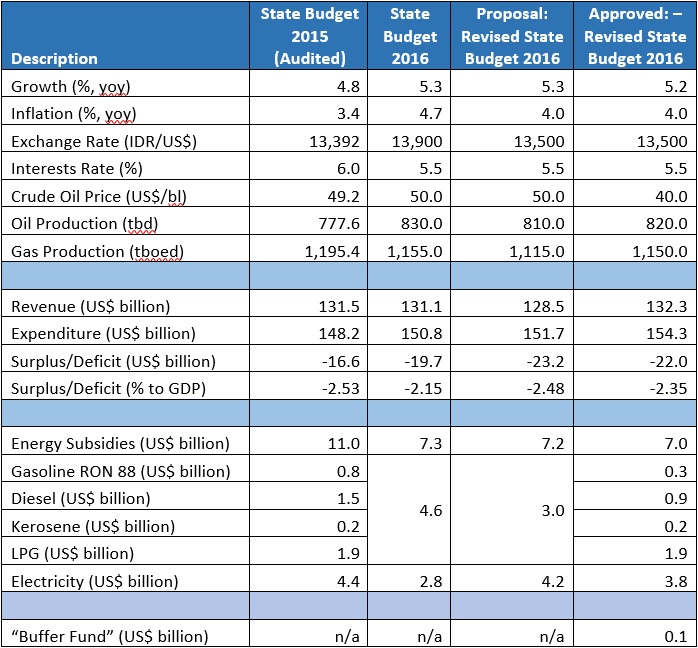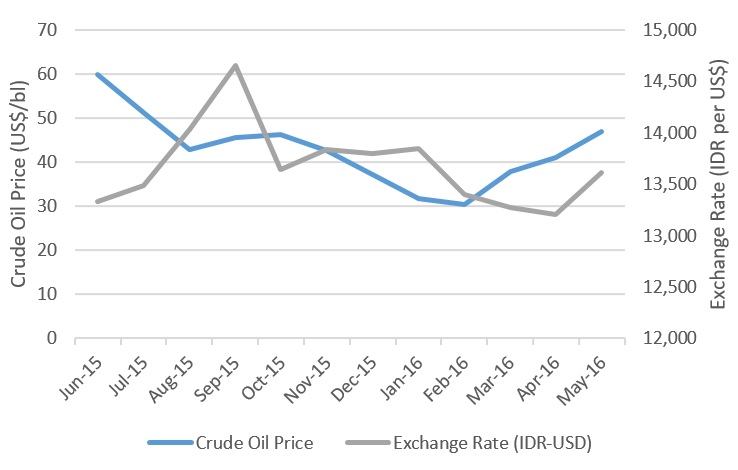Indonesia Approves Revised 2016 Budget: Subsidy update
On 28 June, Indonesia’s government and parliament reached consensus on the revised state budget for 2016. The budget is an important indicator for Indonesia’s subsidies to fossil fuels in the year ahead. This blog provides an overview.
The overall energy subsidy component in the revised state budget 2016 equals US$ 7.0 billion. This is slightly below the government’s original proposal of US$ 7.3 billion, and reflects several changes in the macroeconomic environment and adjustments to Indonesia’s subsidy policies. The budget also saw the introduction of a new post: the so-called “Buffer Fund”, with an allocation linked to the development of the much discussed Energy Security Fund.
Table 1 – Summary of Indonesia’s State Budget 2016

Notes: tbd = thousand barrels per day; tboed = thousands of barrels of oil equivalent per day. Sources: [1]
Macroeconomic changes: energy prices and the exchange rate
Two of the key indicators that normally play an influential role on Indonesian subsidy expenditure—the international energy prices and the IDR-US$ exchange rate—have been relatively stable compared to assumptions in the original 2016 state budget.
International oil prices, which had been dropping steadily since October 2015 to near US$ 30 per barrel, have seen a rebound from February 2016, increasing steadily to levels of around US$ 49 per barrel in October. Gas prices, on the other hand, which determine the cost of Indonesia’s LPG subsidies, have according to the Ministry of Energy and Mineral Resources (MEMR) fallen from US$ 400 per metric ton to US$ 318 per metric ton. [2]
On the exchange rate, the rupiah has strengthened from a position of over IDR 14,000 per US$ in August 2015 to around IDR 13,200 per US$ in May 2016. This has largely been in reaction to the devaluation of the Chinese yuan and an increase in interest rates by the US Federal Reserve. [3]
Higher oil prices will, by and large, increase the per unit cost of subsidizing oil products, while lower gas prices will reduce the per unit cost of subsidizing liquefied petroleum gas (LPG). The stronger exchange rate further lowers the cost of subsidies, by reducing the rupiah cost of any energy product imports required to meet domestic demand. These shifts in prices and the exchange rate have also helped to keep inflationary pressure moderate, down from an initial estimate to 4.7% to 4.0% in the revised budget.
Figure 1 – Crude Oil Price and IDR-USD Exchange Rate

Sources: [4]
Changes in policy planning: electricity, diesel, LPG and kerosene subsidies
In terms of policy change, the three major shifts have been the postponement of electricity subsidy reform, a decision to further reform diesel subsidies and the postponement of LPG and kerosene subsidy reforms.
Delaying electricity subsidy reform is expected to increase subsidy expenditure: from US$ 2.8 billion to US$ 3.8 billion. PT PLN (Indonesia’s state owned electricity company) estimates that, without reform, it will have to sustain costs of approximately US$ 1.3 billion to keep providing electricity to end users at tariffs that do not cover the cost of production until the end of 2016. [5]
Despite the delay, however, electricity subsidies are still expected to be reformed in the near future. Indonesia’s National Team for the Acceleration of Poverty Reduction (TNP2K) is currently in the process of completing verification of electricity subsidy recipients which will subsequently be delivered to PT PLN to inform the reform process. [6] The upcoming reform is expected to exclude non-poor households in the 900VA connection class (currently one of two subsidized connection classes), which would reduce subsidy recipients in that class from 22 million households to 4 million households. [7]
Since the government reformed diesel and gasoline subsidies in January 2015, electricity subsidies have been the most significant energy subsidy post on its state budget.
New plans to further reform diesel subsidies, however, will reduce subsidy expenditure. The proposed reform would see the fixed per litre diesel subsidy of IDR 1,000 (US$ 0.10) fall to IDR 500 (US$ 0.05). The government initially proposed to reduce the fixed subsidy on diesel to IDR 350 (US$ 0.02) per litre, but it was negotiated to IDR 500 (US$ 0.05) during discussions with parliament. The main reason behind the adjustment was a concern of PT Pertamina (Indonesia’s oil and gas state owned enterprise and primary distributor of subsidized fuel) that international oil prices would continue to increase, leaving the pump price of diesel more volatile for consumers and jeopardizing the government’s ambition to keep the retail price of diesel relatively stable. [8]
Finally, plans for the reform of LPG and kerosene subsidies this year—which, like electricity subsidies, are understood to focus on excluding non-poor households—have also been postponed. All things being equal, this would increase the allocations that are required to subsidizing LPG and kerosene, but it is thought that the impact of this on the budget has been effectively neutralized by lower gas prices.
In Focus: The Energy Security Fund
Prior to the budget talks, Minister of Energy and Natural Resources, Sudirman Said, announced that MEMR had received Presidential approval to bring the issue of Indonesia’s Energy Security Fund (Dana Ketahanan Energi) into the annual state budget revision talks. According to Said, Indonesia’s Energy Security Fund would be intended to support five objectives: [9]
- Reducing dependency on imported oil by developing non-fossil fuel energy alternatives;
- Improving electricity access in remote areas (more than 12,500 villages lack adequate electricity access in Indonesia);
- Supporting efforts to achieve the national energy policy target which aims to increase the share of renewable energy mix to 23% of the national energy mix;
- Developing new and renewable energy technologies;
- Establishing a strategic petroleum reserve.
It should be noted, however, in other statements from the government, it has also been stated that the Energy Security Fund will also include a price stabilization function. [10]
The state budget revision ended up with an IDR 1.6 trillion (US$ 118.5 million) budget allocation to a so-called “Buffer Fund”, not equal to the long-debated Energy Security Fund (Dana Ketahanan Energi). [11] The buffer fund has, nevertheless, some specific energy security functions. It is designed to help cushion an energy crisis or emergency situation and is essentially made up of two allocations of IDR 800 billion (US$ 99.3 million): one dedicated to the build-up of strategic petroleum reserves; and one for energy security fund more broadly, with the exact meaning of this yet to be determined. [12] Although the modalities for the buffer fund are not yet established, the fund is intended to be used during energy crises or emergency situations where energy supply is interrupted.
After the budget revision was approved, Minister Said further explained, that the government plans to establish a Public Service Agency (Badan Layanan Umum, BLU) under his ministry, in order to be able to manage the fund. [13] Likewise, he added that the financial needs of a comprehensive Energy Security Fund are actually much bigger than what has been allocated to the Buffer Fund and what can realistically be allocated via the state budget. According to the government, such a fund would ideally be composed of around IDR 1,600 trillion (US$ 118.5 billion) which is around 1,000 times bigger than what was approved by in this year’s revised budget. Thus, the fund’s establishment will require contributions from a variety of different sources, including the private sector and state-owned enterprises.
Although current funding is not yet sufficient to establish an Energy Security Fund that can deliver upon all five of its ambitions, it is still a significant milestone that the government was able to carry a new post into the state budget. This is normally a challenging exercise and thus an important first step in the potential development of such an initiative.
References
[1] Ministry of Finance, Government of Indonesia. (2016a). Central Government Financial Report 2015.
Ministry of Finance, Government of Indonesia. (2016b). Revised State Budget 2016 Proposal.
[2] Katadata. (2016, June 14). Pemerintah Batal Kurangi Dana Subsidi Elpiji. Retrieved from http://katadata.co.id/berita/2016/06/14/pemerintah-batal-kurangi-subsidi...
[3] Liputan6. (2015, August 21). Rupiah Kembali Jatuh ke 13.943 per Dolar AS. Retrieved from http://bisnis.liputan6.com/read/2298601/rupiah-kembali-jatuh-ke-13943-pe...
[4] Index Mundi. (n.d.). Crude Oil (petroleum); West Texas Intermediate. Retrieved from http://www.indexmundi.com/commodities/?commodity=crude-oil-west-texas-in...
Bank of Indonesia. (n.d.). Foreign Exchange Rate. Retrieved from http://www.bi.go.id/en/moneter/informasi-kurs/transaksi-bi/Default.aspx
[5] Sindonews (16 June, 2016). Tambahan Subsidi Ditolak, PLN Bakal Naikkan Tarif Listrik 900 VA. Retrieved from: http://ekbis.sindonews.com/read/1117288/34/tambahan-subsidi-ditolak-pln-...
[6] Merdeka (8 June, 2016). Pemerintah Ragu Pencabutan Subsidi Listrik 900 VA Bisa Tercapai. Retrieved from: http://www.merdeka.com/uang/pemerintah-ragu-pencabutan-subsidi-listrik-9...
[7] Jakarta (18 June, 2016). PLN May Increase Rates if Subsidy Funding Stays As Is. Retrieved from: http://www.thejakartapost.com/news/2016/06/18/pln-may-increase-rates-if-...
BeritaSatu (27 June, 2016). Wakil Ketua Komisi VII: Subsidi Listrik Tidak Usah Lewat PLN. Retrieved from: http://www.beritasatu.com/nasional/372129-wakil-ketua-komisi-vii-subsidi...
[8] Sindonews (14 June, 2016). Subsidi Solar Dicabut, Menteri ESDM Bantah Bakal Naikkan Harga. Retrieved from: http://ekbis.sindonews.com/read/1116536/34/subsidi-solar-dicabut-menteri...
Detik (15 June, 2016). Pertamina Minta Subsidi Solar Minimal Rp 500/Liter, Ini Kata Menteri ESDM. Retrieved from: http://finance.detik.com/read/2016/06/15/123747/3233851/1034/pertamina-m...
[9] Metro TV. (2016, July 5). 5 Alasan Dana Ketahanan Energi Diperlukan. Retrieved from http://ekonomi.metrotvnews.com/energi/yNL8ZdyN-5-alasan-dana-ketahanan-e...
[10] Directorate General of New Renewable and Energy Conservation (16 March, 2016). Badan Pengelola DKE Akan Diatur Dalam Perpres. Retrieved from: http://ebtke.esdm.go.id/post/2016/03/10/1150/badan.pengelola.dke.akan.di...
Directorate General of Oil and Natural Gas (10 March, 2016). DKE Diharap Masuk APBN-P 2016. Retrieved from: http://www.migas.esdm.go.id/post/read/dke-diharap-masuk-apbn-p-2016
Metro TV (5 July, 2016). Ini Sumber Dana DKE. Retrieved from: http://ekonomi.metrotvnews.com/energi/JKR42E7b-ini-sumber-dana-dke
[11] Ministry of Finance, Government of Indonesia. (2016, July 1). Rancangan APBN Perubahan 2016. Retrieved from http://www.anggaran.depkeu.go.id/content/publikasi/advertorialrapbnp2016...
[12] Kontan. (2016, June 6). Dana ketahanan energi disiapkan Rp 1,6 triliun. Retrieved from http://nasional.kontan.co.id/news/dana-ketahanan-energi-disiapkan-rp-16-...
[13] Energy Today. (2016, July 8). Menteri ESDM: DKE Butuh Anggaran Rp 1.600 Triliun. Retrieved from http://energitoday.com/2016/07/menteri-esdm-dke-butuh-anggaran-rp-1-600-...
